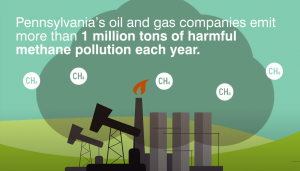Data underscores need to strengthen Pennsylvania’s methane rule proposal
 In July, Pennsylvania’s Department of Environmental Protection concluded its public comment period on proposed rules to curb methane emissions from existing oil and gas facilities.
In July, Pennsylvania’s Department of Environmental Protection concluded its public comment period on proposed rules to curb methane emissions from existing oil and gas facilities.
As the state weighs feedback, EDF analysis shows Pennsylvania operators emit over 1 million tons of methane annually — 16 times what they report to regulators — and underscores the need for rules that close existing loopholes to properly address this climate and public health risk.
Gov. Tom Wolf’s administration has already demonstrated leadership on methane with permits to cut pollution from new oil and gas infrastructure. Now Pennsylvania has an opportunity to tackle the vast majority of its methane emissions, which come from existing oil and gas facilities.
Pennsylvania’s million-ton methane problem
EDF’s analysis, informed by updated production data and the latest peer-reviewed modeling, uncovers a million-ton methane problem in Pennsylvania.
Data underscores need to strengthen Pennsylvania’s methane rule proposal Share on XMethane — the main component of natural gas — drives a quarter of current global warming, and curbing this potent greenhouse gas is one of the fastest, most cost-effective ways to address climate change and the threat it poses to Pennsylvania’s communities and their well-being.
Recent peer-reviewed science underscores the urgent need to address methane from the oil and gas sector, which accounted for 80% of North America’s continuing surge in methane emissions.
The more than 1 million tons of methane emitted annually by Pennsylvania oil and gas operators has double the climate impact of all the cars in the state combined, and without stronger rules in place EDF estimates companies will emit nearly 15 million tons of methane pollution by 2030.
Last year, Gov. Wolf set the goal of curbing Pennsylvania’s climate pollution 26% by 2025 and 80% by 2050 and reaffirmed his commitment to, “continue reductions of potent greenhouse
gasses such as methane.” Attaining those goals is critical for staving off the worst impacts of climate change in Pennsylvania, including longer and hotter summers that worsen air pollution, severe weather such as flooding, and higher incidence of vector-borne diseases. Local communities’ health and well-being depends on having strong methane protections in place.
Data-driven and cost-effective solutions
Fortunately, by strengthening DEP’s proposed existing source rule Pennsylvania can reduce methane emissions by about 60%. As proposed, the current rule would leave nearly half of these reductions on the table, with a broad swath of emissions left unchecked.
Because methane is the primary constituent of natural gas, capturing emissions and preventing leaks means that oil and gas companies can bring more saleable product to market. In fact, the state’s million-plus tons of methane emissions translate to about 57 billion cubic feet of natural gas. Thankfully, solutions to cutting methane emissions are cost-effective, and the International Energy Agency reports that even in today’s low-cost environment one-third of emissions can be reduced at no net-cost.
Gov. Wolf and the DEP should strengthen its draft rule in two important ways:
- Closing the current loophole that excludes low-producing wells, which account for more than half of Pennsylvania’s oil and gas-related methane emissions.
- Removing a step-down provision that allows operators to skip inspections purely because previous checks did not reveal significant leaks. The latest research and experience of other states show that large, uncontrolled leaks can happen at any time and can only be detected with frequent, regular inspections.
Implementing these changes to secure strong methane rules is more critical now than ever, as the IEA warns that emissions could increase as companies cut staff and dial back voluntary efforts to reduce emissions.
Building policies guided by sound science and the best available data is integral for ensuring Pennsylvania communities’ health and climate is safeguarded. As the second-largest producer of natural gas in the nation, the state has an obligation to lead.












